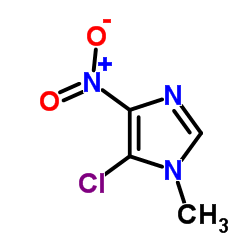5-Chloro-1-methyl-4-nitroimidazole

5-Chloro-1-methyl-4-nitroimidazole structure
|
Common Name | 5-Chloro-1-methyl-4-nitroimidazole | ||
|---|---|---|---|---|
| CAS Number | 4897-25-0 | Molecular Weight | 161.55 | |
| Density | 1.7±0.1 g/cm3 | Boiling Point | 362.3±22.0 °C at 760 mmHg | |
| Molecular Formula | C4H4ClN3O2 | Melting Point | 148-150 °C(lit.) | |
| MSDS | USA | Flash Point | 172.9±22.3 °C | |
| Symbol |

GHS07 |
Signal Word | Warning | |
|
New synthesis and antiparasitic activity of model 5-aryl-1-methyl-4-nitroimidazoles.
Molecules 14(8) , 2758-67, (2009) A number of 5-aryl-1-methyl-4-nitroimidazoles 5a-f have been synthesized in good yields by the Suzuki coupling reaction between 5-chloro-1-methyl-4-nitroimidazole (3) and arylboronic acids 4a-f, aided by dichlorobis-(triphenylphosphine)palladium(II), K(2)CO(3... |
|
|
Rapid-mix studies on the anomalous radiosensitization of mammalian cells by 5-chloro-1-methyl-4-nitromidazole.
Int. J. Radiat. Biol. Relat. Stud. Phys. Chem. Med. 38(6) , 673-5, (1980)
|
|
|
The kinetics of the reaction of 'anomalous' 4-nitroimidazole radiosensitizers with thiols.
Int. J. Radiat. Biol. Relat. Stud. Phys. Chem. Med. 41(2) , 231-5, (1982)
|
|
|
Are ortho-substituted 4-nitroimidazoles a new generation of radiation-induced arylating agents?
Int. J. Radiat. Biol. Relat. Stud. Phys. Chem. Med. 37(4) , 463-8, (1980)
|
|
|
Glutathione-reactive nitro compounds as radiosensitizers: mechanistic and therapeutic implications.
Int. J. Radiat. Oncol. Biol. Phys. 12(7) , 1135-8, (1986) The "extra" radiosensitization seen with GSH-reactive nitro compounds is too large to be accounted for by GSH-depletion acting independently--there must be competition. The GS-conjugate leaks out of cells slowly and is trapped at high concentrations. Its prop... |
|
|
Occupational allergic contact dermatitis from 5-chloro-1-methyl-4-nitroimidazole.
Contact Dermatitis 36(1) , 53-4, (1997)
|
|
|
2-Chloro-4-nitroimidazole radiosensitizers of hypoxic tumor cells in vivo.
Neoplasma 34(3) , 253-9, (1987) The transplantable rhabdomyosarcoma in WAG/Rij rats was used to test the in vivo effectiveness of 1-methyl-2-chloro-4-nitroimidazole (P13) and its analog 1-(2-hydroxy-3-methoxy-propyl)-2-chloro-4-nitroimidazole (P40) as tumor-cell radiosensitizers after their... |
|
|
The effect of electron-affinic radiosensitizers on ATP levels in V79 379A Chinese hamster cells.
Biochem. Pharmacol. 36(3) , 393-6, (1987)
|